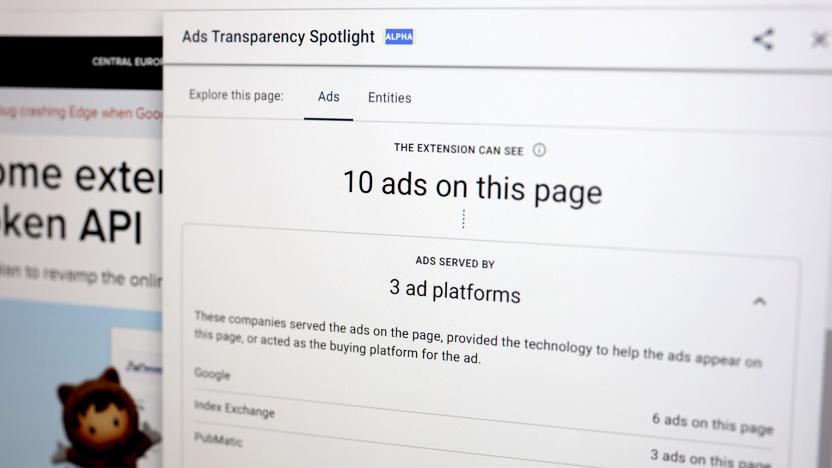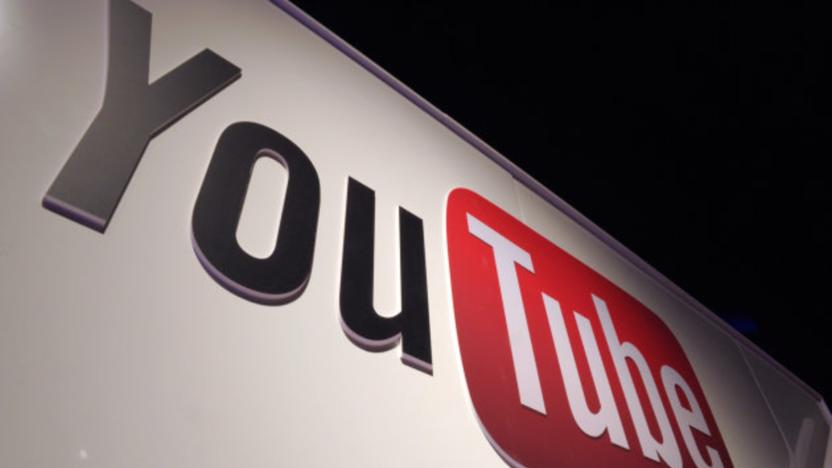advertisers
Latest

Google's latest Chrome extension shows detailed ad-tracking data
Google has released a Chrome extension that can give you more insight into how you’re being targeted by advertisers. Called “Ads Transparency Spotlight,” it shows the number ads loading on a page, the advertisers and ad tech companies present, and your personal data (demographics, re-marketing, interests, location, etc.) being used to serve the ads.

YouTube will make it easier for 'edgy' creators to find advertisers
YouTube has a tricky job of making sure ads don't show up alongside videos promoting extremist, hateful views or violence, yet also making sure it doesn't strip creators, who may post things like violent video game scenes, of their revenue-earning potential. In an attempt to get better at that, YouTube is experimenting with ways to match "edgy" videos with advertisers who are okay with content that's not totally PG.

Twitter may have shared your data without permission
Yesterday, Twitter came clean about a data mishap. According to the company, it may have shared data it didn't have permission to with advertisers. It may have also made assumptions about what device you use, again without permission.

Offensive YouTube videos won't earn ad money from Google
YouTube released new creator guidelines today, clarifying what makes videos ad-friendly and expanding the restrictions that deem videos ineligible to earn advertising revenue. The stricter rules are an attempt to make sure ads don't appear on videos that advertisers deem offensive or inappropriate.

Google vows to pull ads from extreme videos and sites
Google has detailed new safeguards to ensure brands don't have their adverts served against extremist content. The measures follow a wave of complaints and advertising withdrawals by the UK government, Audi and L'Oreal, among others, triggered by a Times investigation which revealed a number of adverts being shown alongside harmful and inappropriate videos on YouTube. In a blog post, Google said it would be taking "a tougher stance" and "removing ads more effectively" from content that is attacking people based on their race, religion or gender. It also promised to hire "significant numbers" of new staff to review "questionable content."

Ad groups ask FCC to reconsider ISP tracking opt-in rules
If you ask most Americans which company they'd least trust with their data, the answer would probably be "Comcast," or maybe "Time Warner Cable" -- both ranked in the bottom four of Temkin's 2016 trust ratings. That's perhaps why the FCC decided to force broadband providers to get your permission before collecting private browsing data, rather than putting the onus on you to opt out. However, advertising groups have petitioned the agency to reconsider the rule, calling it "onerous" and a violation of first amendment commercial speech protections

Windows 8 RTM will include 'do not track' by default for Internet Explorer 10
Many advertisers weren't thrilled when Microsoft proclaimed that 'do not track' would be the default for Internet Explorer 10 on Windows 8, but that reaction hasn't made the folks in Redmond flinch. Brendon Lynch, the company's Chief Privacy Officer, announced that the 'do not track' default is already baked into the code of the October-bound operating system that has been released to manufacturers. Upon booting Windows 8 for the first time, users will be greeted with a choice between "Express Settings" or "Customize," the former of which has "do not track" enabled. IE 10 on Windows 7 will receive a similar treatment, with a "prominent notice" about the setting being switched on appearing alongside a link to additional information. Despite Microsoft's efforts, it's possible that advertisers could ignore the web browser setting if they feel their negotiations have been for naught. Considering the response to Microsoft's initial default announcement, we suspect this won't be the last development in the saga. [Image credit: Tomas Fano, Flickr]

Chrome and Firefox adding new opt-out features to prevent third-party advertisers from tracking you
Ever been freaked out by an online ad that seemed to know you that little bit too well? It's the result of good old advertisers tracking your net-navigating habits and delivering targeted commercials to your eyeballs, but it can be prevented. Both Google and Mozilla have stepped up (or perhaps been pushed by the FTC) to try and tackle this issue of pernicious tracking cookies, but they've gone about it in different ways. The Chrome solution is a Keep My Opt-Outs browser extension that remembers the sites you don't want personalized information from, while Firefox will start beaming out a Do Not Track HTTP header that should be respected by advertisers and result in you receiving generic, repetitive ads. The important commonality between the two is that they don't rely on you preparing a cookie file with all your anti-advertiser bile contained within it (which was the FTC's original, somewhat impractical idea). Google intends to open-source its extension and bring it to other browsers as well, though obviously it's taking care of Chrome first, which can benefit from the add-on right now.

Advertisers, broadcasters fight over who owns the HD sidebars during 4x3 commercials
Surprisingly, even in 2010 not every commercial on high definition channels is actually in HD, and for channels like TBS that fill in the sides of 4x3 content with their own branded bars, advertisers are suddenly finding issue with competing for screen space. Things reached a head when TBS used its bars to promote the new late night Conan show, and now the Association of National Advertisers has come out with a statement indicating the sidebars belong to the advertiser, not the network, while the ad is running unless otherwise agreed. Of course, simply making commercials in HD (if they're going to be on, they should at least look good) would fix this, but until then well see who has the upper hand in this battle of wills.

TiVo issues 30 for 30 interactive ad challenge to shift how brands buy advertising
The way TiVo sees things, advertisers shouldn't foolishly pay for ads no one is watching thanks to their DVRs, when they could use the same money to pay TiVo -- a DVR company -- for special ads DVR users are more likely to see. At least that's what we're getting from their recently announced 30 for 30 interactive ad challenge, which involves asking advertisers to move money from poorly performing prime-time 30-second TV spots and instead put it towards buying 30 days of ad exposure on TiVo. For those unfamiliar with TiVo's ad offerings, this exposure appears as clever advertisements shown in places such as the pause menu and home screen, or via special placements through fast-forward billboards and interactive tags that appear during regular commercials. While this may be bad news for TiVo's commercial-hating users who bought the device to avoid ads in the first place, depending on the trial's success, we're hoping TiVo could earn enough dough to drop the monthly subscription fee -- that is as long as VOD doesn't make the discussion moot. Sure the concept is crazy enough to make even Joseph Heller proud, but thankfully whatever happens, there's still HBO.

Study finds commercial-skipping DVRs don't affect purchases, 'TiVo effect' may not exist
Two years back, consumer research told us the vast majority of DVR users skipped commercials; now, statisticians at Duke University say that's not the case. More importantly, even those who do hit that oh-so-tempting skip button aren't necessarily spending less on advertised products as a result. Pulling data from over 1,200 TiVo boxes over the course of three years, Professor Carl Mela and colleagues found that a staggering 95 percent of television was watched live instead of recorded, giving viewers no opportunity to skip, and even when there was an opportunity, users took it only 6.5 percent of the time. Moreover, every attempt the researchers made to find a "TiVo effect" failed -- comparing those who had DVRs with those who didn't, they found no significant difference in the amount TV watchers spent on nine different goods (including cleaning and grooming products) advertised. This could be for a variety of reasons -- perhaps advertising doesn't work, period, or perhaps those without DVRs "skipped" commercials simply by walking out of the room -- but no matter the reason, it seems these days television advertisers don't have quite so much to fear.

Apple's video advertising options detailed in patent application
In the battle of the network superstars between free-to-stream, ad-supported video (the Hulu model) and pay-per-show, ad-free TV (the iTunes model), there's been a big missing piece: how to monetize shows and sell ads for content that's downloaded and played on mobile devices like the iPad? Obviously, it's a better deal for the user if they can watch at will, without having to maintain network connectivity on the go (to say nothing of the streaming quality, or lack thereof, when connected over 3G), but making sure they see the ads in the content -- and reporting back to advertisers who want to know who watched what -- is much more challenging for anywhere, anytime viewers. Wherever there's trouble, they're there on the double: the Bloodhound Gang known as Apple's engineering team has a patent application that may offer a way forward. First filed in September of 2008 and made public on March 4, this patent received a thorough analysis over at Patently Apple. The core idea: watch a block of ads to 'unlock' the next segment of video content, not unlike the way most network streaming sites appear to work now. The difference is in the implementation, reporting and controlling how the ads appear and which content is freed up. Users might be able to 'pay past' the ads, or watch them all at the beginning of the program to deliver a more seamless viewing session. More intriguingly, Apple's patents suggest that advertisers can require or customize a particular level & kind of user interaction that will be embedded in the ad experience, requiring viewers to engage on some level before proceeding to the next segment (thereby ensuring that they're paying attention and not off making a snack). That would be something of a Holy Grail for advertisers who fear that their messaging is getting lost in the TiVo/DVR 'just skip it' timeshifting era. Combined with the October 2009 patent regarding ad-subsidized hardware platforms, which lists Steve Jobs and Mike Matas among its co-inventors, and it's looking like we might be moving towards a future where that $499 iPad can be had for a fantastic, subsidized price of $199... if you accept a certain level of embedded and un-skippable advertising alongside your media and mobility experience. "Magical & revolutionary," you betcha. The idea of power-ads taking over your media playback might not bother everyone, but if you buy Fake Steve's argument, that's where the $30/month TV subscription plan comes in. Can't take the ads? Just pay to play. [via MacRumors] Image from Apple patent, courtesy Patently Apple site. No comment on the fact that it looks like a picture of Charlie from Lost (Dominic Monaghan).

'American Idol' is most timeshifted show of 2008
Well, would you let your brain simmer on this a bit. American Idol, the famed singing competition that airs live numerous times per week when it's in full swing, was found to be the most timeshifted program in the USA in 2008. Granted, it's also the most watched show in the nation, but we digress. The significance here is that this tidbit, which was dug up by The Nielsen Company, goes to show that live competitions and so-called "topical" programming aren't as immune to DVRs as networks would love to believe. The data found that "an extra four million viewers watched Fox's American Idol in the seven days following the initial episodes." To us, the only true DVR-resistant programming is live sports -- the genuineness of the event just seems to fade when you're not watching in real time, but we can't say we've ever felt the same when watching Simon & Co. a few days after the fact.

Macrovision to scrutinize Sunflower Broadband in-guide advertising
With Disney creating a dedicated lair for biometric testing of advertisements and Backchannelmedia pushing its own TV-to-internet ad platform, we aren't too surprised to see Macrovision teaming up with Sunflower Broadband to gauge the effectiveness of yet another advertising alternative. As part of the collaborative effort, EPG usage patterns of an "anonymous sample of Sunflower customers" will be collected and scrutinized in order to "gain insight into how consumers use i-Guide and interact with their DVR, on-demand services and in-guide advertising." In essence, the data will be used to "develop more effective consumer marketing tactics" and understand how subscribers "engage with interactive guide advertising." In-guide advertising? We hate to even think it, but really, what's next?

Nielsen & Charter track second-by-second viewing, know you love Hannah Montana
Not content to let Tivo and TNS have all the second-by-second viewer tracking fun, Nielsen has teamed up with Charter Communications to track every moment of viewing from 320,000 households in LA. Nielsen is the most famous rating system, but so far its lagged behind the competition in pulling data directly from set-top's, although even that doesn't tell the whole story. Without its traditional system, there's no way to tell what people really watched, or if they just walked away ten minutes into the Knight Rider remake (We watched all the way through cuz we love The Hoff that much). As far as the viewers tracked (consent is not considered necessary), we just hope they're watching HD.[Via BlogRunner]

Super Bowl XLII sets viewership record, commercials still more popular
You could almost see this one coming -- a Super Bowl with one team attempting to do what no other team in league history has done? Yeah, that'll draw folks in. A game decided in the final minutes of the fourth quarter helps too, and according to research doled out by Nielsen, Sunday's tilt between the Giants and Patriots was indeed the most watched Super Bowl ever. Reportedly, some 97.5 million viewers tuned in on average, with 105.7 million fixing their eyes on the game between 9:30PM and 10:00PM EST. More interesting, however, was TiVo's research data, which showed that more folks (in its sample, at least) were interested in watching / rewinding commercials than actually pausing to gaze into Brady's eyes. Oh, and for those curious, E-Trade's "Baby" spot snatched the number one rank this year in term's of ad popularity (sorry, Toshiba). Hit up the read links below for oodles more data about the game.[Image courtesy of Getty Images / WNBC]Read - Nielsen's research dataRead - TiVo's research data

DirecTV and TNS partner up to analyze "second-by-second" viewing habits
Listen up, DirecTV users -- select TiVo customers aren't the only ones having their viewing habits inspected with a microscope. Apparently, your satellite provider has just teamed up with TNS Media Research to find a willing audience (read: opt-in participants only) of 100,000 folks that will allow the two to closely analyze exactly what they do when camped in front of the tube. More specifically, TNS is hoping to launch DIRECTView later this year, which will measure "the total viewing [of the aforementioned group], including the live and time-shifted (DVR) viewing of programs and commercials at a second-by-second interval." According to Eric Shanks, EVP of DirecTV Entertainment, the goal here "is to develop a panel capability that will provide important insights across its advertising platform," which will "in turn provide its advertisers and programming partners [with] an unparalleled level of measurement accuracy and accountability." It's also pretty creepy, but unfortunately, not at all surprising.

Virtual worlds and the problems advertisers face
Recently, OMMA (the magazine for Online Media, Marketing and Advertising -- wait a magazine for ... online marketing?) posted its "10 Things You Need to Know About Social Networking" article to its website. The piece begins by stating that next year $1.38 billion (that's with a "b", people!) is what they're expecting to be spent towards ads on social networks. Well that's fine and dandy, but what does this whole thing have to do with virtual worlds you ask?Well, in their list OMMA stops to talk momentarily about virtual communities such as Second Life. All sorts of brands have run head-first into Second Life over the past year or two, but so far there hasn't been much community-buzz around their presence. If you've ever logged into the world of Second Life to check out any of the corporate happenings there you would probably find a lot of tumbleweeds. Nobody wants to just come and look at your virtual store and stare at virtual product they might be able to buy. Worlds In Motion makes a good point when they say that you've got to have some interactivity with people.It wouldn't it kill these companies to reach out to the community in creative ways and maybe do a little research into what could work. It certainly works the other way around, so why not get creative and generate some buzz inside these worlds?[via Worlds in Motion]

Textual ads destined to hit shopping cart handles
As marketers continue to search for (and exploit) places in which you'd never think to find an ad, it makes sense to scroll a few plugs through an item that the vast majority of us spend at least a few hours per week touching. That item, dear friends, is the handle of the tried and true shopping cart, and apparently, Modstream is hoping to install bars with scrolling displays onto buggies and allow companies to beam in messages wirelessly. The system works by allowing outfits to access a web-based profile, enter in a given message, and transmit the ad to participating stores. As an added bonus, the setup enables said companies to change up their messages on a whim and keeps us shoppers guessing as to what clever line is coming next. Now, who's down with hacking this thing to scroll through our favorite RSS feeds?[Via Textually]

TiVo looks to serve up demographic data to marketers
Don't you dare criticize TiVo's ad collecting / disseminating department for slacking off, as just months after it launched StopWatch to offer up second-by-second viewing data, the company is planning to also hand over demographic information about its customers. The move is certainly likely to shift TiVo into Big Brother's list of most highly-regarded outfits, as the information that will soon be shared with advertisers (we're hearing it may be opt-in only, however) includes "age, income, marital status and ethnicity." There's no telling how much coinage TiVo will be raking in for such detailed data, but at least willing users can now watch intently knowing full well that they're letting it all (and we mean all) hang out. Update: Turns out this is indeed an opt-in program. Thanks, Jake! [Via Reuters]







